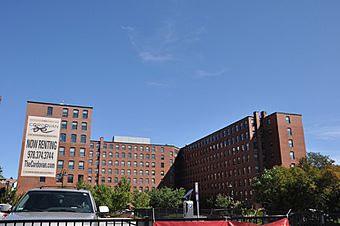Haverhill Board of Trade Building facts for kids
Quick facts for kids |
|
|
Haverhill Board of Trade Building
|
|
 |
|
| Location | Haverhill, Massachusetts |
|---|---|
| Area | 1.3 acres (0.53 ha) |
| Built | 1906 |
| Architect | Damon Brothers |
| NRHP reference No. | 07001008 |
| Added to NRHP | September 28, 2007 |
The Haverhill Board of Trade Building is a very old factory building in Haverhill, Massachusetts. It's a big brick building with seven floors. Local business leaders, called the Haverhill Board of Trade, built it between 1906 and 1908. Their goal was to offer affordable factory space to small businesses. Many of these businesses made shoes, which was a very important industry in Haverhill back then. This building also helped the city's business area grow into new parts of town. In 2007, it was added to the National Register of Historic Places. Today, it has been changed into homes.
Contents
What is the Haverhill Board of Trade Building?
The Haverhill Board of Trade Building is on Walnut Street. It's just a short distance north of Washington Street, which is the main street in downtown Haverhill. The building takes up most of the block between Emerson and Locust Streets.
How Does the Building Look?
It's a large brick building shaped like the letter "U." The open part of the "U" faces south. The front of the building, facing Walnut Street, is very wide. It has 25 sections, called bays. This front part also has the most interesting decorations.
Special Features of the Building
The main special features are its two main entrances. Each entrance is four bays in from the ends of the building. They both have round-shaped openings. These openings are decorated with brick pillars and a fancy tooth-like pattern around the arch. Most of the building is made of red brick. However, the sections at the very ends are a lighter, buff color. There is also a decorative band of buff-colored brickwork between the second and third floors across the front.
Why Was This Building Built?
The idea and building of this factory from 1906 to 1908 changed how Haverhill thought about growing its industries. At that time, Haverhill was one of the top cities in the country for making shoes.
The Board of Trade's Goal
In 1901, the city's business leaders created the Haverhill Board of Trade. Their main goal was to help the local economy grow. They wanted to build a place that would act like a "business incubator." This means it would help small businesses start and grow by giving them a place to work.
Expanding Haverhill's Industry
This building also marked a big step for the city. It helped industrial areas spread out from Washington and Essex Streets. Before this, most factories were located only in those areas.
A Home for Shoe Businesses
The building was constructed in three separate parts. This happened as the Board of Trade bought more land. Once finished, the building quickly filled up with many small companies. Most of these companies made shoes or provided services for shoe factories.
Changes Over Time
In the 1930s, it became harder for shoe companies to compete. Because of this, other types of businesses started to move into the building.
New Owners and Uses
The Board of Trade sold the three parts of the building to different owners in 1944 and 1945. Even with new owners, shoe-related businesses continued to use parts of the building until 1969. Later, a furniture company called Cabot Furniture used two of the three parts as its main office and showroom. They owned these parts until 2004.
The Building Today
In 2004, all three parts of the building were bought by one owner again. Since then, the Haverhill Board of Trade Building has been changed into residential units, meaning people now live there.



